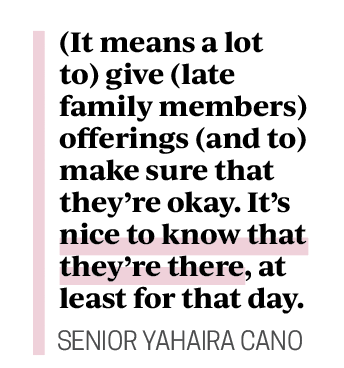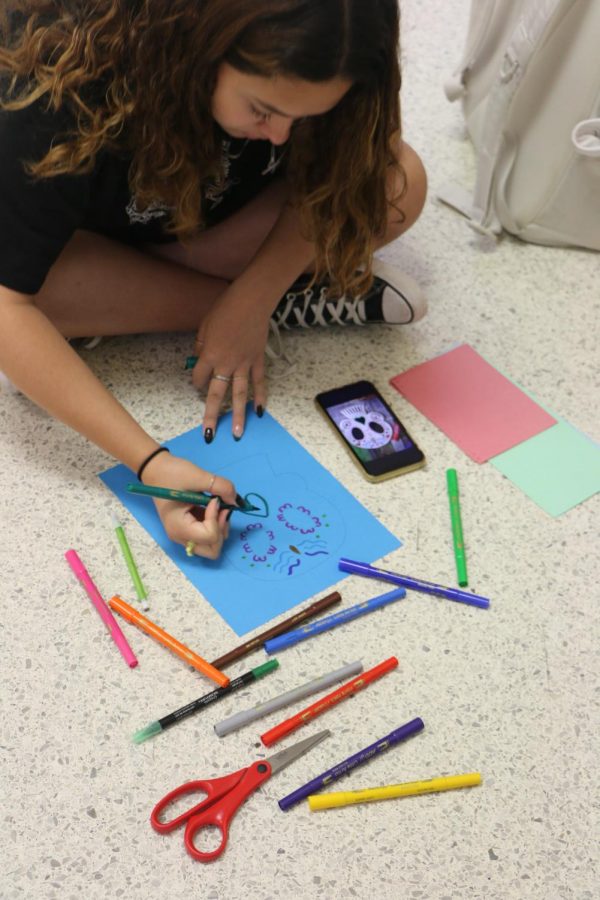Freshman Regina Hyde carefully traces the shape of a skull onto blue colored paper. She goes in with different color markers, highlighting details and adding decorations. She said the skull was to be a decoration for the upcoming festival Día de los Muertos, or the Day of the Dead.
“It’s a day where we don’t celebrate death, we celebrate life,” Hyde said.
According to Gabriela Mendoza, Spanish teacher and former resident of Mexico, this is a festival to celebrate loved ones who have since passed away. Usually celebrated on Nov. 1 and Nov. 2, this holiday is a chance to remember loved ones, and hoping they come back to visit, as many believe, Mendoza said.
Mendoza said people in Mexico often visit cemeteries and decorate their loved ones’ graves, lighting a path to their home so the spirits can find their way.
Senior Yahaira Cano said her family typically begins preparing for Día de los Muertos at least a week before the actual celebration. Cano said her family carefully builds an altar, called an ofrenda in Spanish, to put up photos of loved ones and other decorations.
“It’s just so (that) everything turns out perfect,” Cano said. “(It’s to make sure) nothing’s missing (and) nobody’s missing, because if their picture is not on there, they cannot visit.”

These decorations could also include favorite items of passed family members, such as their favorite food, clothes and toys, Hyde said.
Decorations representing each of the four classical elements—water, fire, wind and earth— are used as well, Hyde said.
Orange flowers, such as marigolds, are of great importance for decoration as well, Cano said.
“We put the flowers there to guide the spirits to the altar,” she said.
Mendoza also said types of decorations may differ between families and across cities in Mexico.
“Some cities have Día de los Muertos parades, like Oaxaca. (Oaxaca) is probably known for their Day of the Dead celebrations, and people travel to see it and be a part of it,” she said.
Cano said, “For my family, on the Day of the Dead, we all talk to our family members and we go visit their cemeteries—the ones that are closest to us—and we eat pan dulce, which is a sweet bread.” She also said some family members stay up and talk the night away, and have a good time.
For Hyde, the celebration features a lot of decorated sugar skulls made by her mother, decorating the house and putting both sugar skulls and decorations up together. She said although they don’t make a whole altar, they will put up photos and favorite items of their loved ones.
Mendoza said pan de muertos is also a famous marker of the celebration. She said it is a bread made of cinnamon and anise and one of the items she first thinks of in relation to Día de los Muertos.

Cano and Hyde said the celebration in itself held a lot of special meanings for them.
Hyde said it was a special day as she would feel more connected to her loved ones and remember and celebrate their lives.
“To me, it honestly means that I get to be able to connect with my family members (who) have passed and kind of be with them again,” Cano said. “(It means a lot to) give them offerings (and to) make sure that they’re okay. It’s nice to know that they’re there, at least for that day,” she said.
Cano said Día de los Muertos especially holds a lot of meaning for her as it is a way for her to connect with her baby sister Yelena who passed away at the age of five months.
“My favorite memory (of celebrating Día de los Muertos) was actually last year. We made this huge altar, and I drew a picture of her for art class a couple years ago, so I put that up as her picture,” Cano said. “It was a very special moment since I’m the only girl in my family, having that moment with my baby sister was really, really nice.”
As Día de los Muertos is important to Hyde, she said while she was happy about it’s growing popularity in the States, she didn’t like the commercialization of it.
“I feel like it’s good but bad at the same time,” she said. “Sometimes, people can think that it’s like Halloween and take it more of (as) dressing up like scary people, and romanticizing death, but it’s not so bad now that people are learning about it,” Hyde said.
Mendoza also said remembering loved ones was something anyone could do and was not tied into any culture, and if people who are not Hispanic wanted to honor their loved ones, they should.
Hyde said, “If you wanna try (Día de los Muertos) out, you definitely should. It’s a really good holiday that people should learn more about.
“I feel like it’s really important because it makes you feel not so scared of (death),” she added. “People get really scared of dying or being forgotten, when really you actually have a lot of people that care about you.”































![What happened to theater etiquette? [opinion]](https://hilite.org/wp-content/uploads/2025/04/Entertainment-Perspective-Cover-1200x471.jpg)














































![Review: “The Immortal Soul Salvage Yard:” A criminally underrated poetry collection [MUSE]](https://hilite.org/wp-content/uploads/2025/03/71cju6TvqmL._AC_UF10001000_QL80_.jpg)
![Review: "Dog Man" is Unapologetically Chaotic [MUSE]](https://hilite.org/wp-content/uploads/2025/03/dogman-1200x700.jpg)
![Review: "Ne Zha 2": The WeChat family reunion I didn’t know I needed [MUSE]](https://hilite.org/wp-content/uploads/2025/03/unnamed-4.png)
![Review in Print: Maripaz Villar brings a delightfully unique style to the world of WEBTOON [MUSE]](https://hilite.org/wp-content/uploads/2023/12/maripazcover-1200x960.jpg)
![Review: “The Sword of Kaigen” is a masterpiece [MUSE]](https://hilite.org/wp-content/uploads/2023/11/Screenshot-2023-11-26-201051.png)
![Review: Gateron Oil Kings, great linear switches, okay price [MUSE]](https://hilite.org/wp-content/uploads/2023/11/Screenshot-2023-11-26-200553.png)
![Review: “A Haunting in Venice” is a significant improvement from other Agatha Christie adaptations [MUSE]](https://hilite.org/wp-content/uploads/2023/11/e7ee2938a6d422669771bce6d8088521.jpg)
![Review: A Thanksgiving story from elementary school, still just as interesting [MUSE]](https://hilite.org/wp-content/uploads/2023/11/Screenshot-2023-11-26-195514-987x1200.png)
![Review: "When I Fly Towards You", cute, uplifting youth drama [MUSE]](https://hilite.org/wp-content/uploads/2023/09/When-I-Fly-Towards-You-Chinese-drama.png)
![Postcards from Muse: Hawaii Travel Diary [MUSE]](https://hilite.org/wp-content/uploads/2023/09/My-project-1-1200x1200.jpg)
![Review: "Ladybug & Cat Noir: The Movie," departure from original show [MUSE]](https://hilite.org/wp-content/uploads/2023/09/Ladybug__Cat_Noir_-_The_Movie_poster.jpg)
![Review in Print: "Hidden Love" is the cute, uplifting drama everyone needs [MUSE]](https://hilite.org/wp-content/uploads/2023/09/hiddenlovecover-e1693597208225-1030x1200.png)
![Review in Print: "Heartstopper" is the heartwarming queer romance we all need [MUSE]](https://hilite.org/wp-content/uploads/2023/08/museheartstoppercover-1200x654.png)



